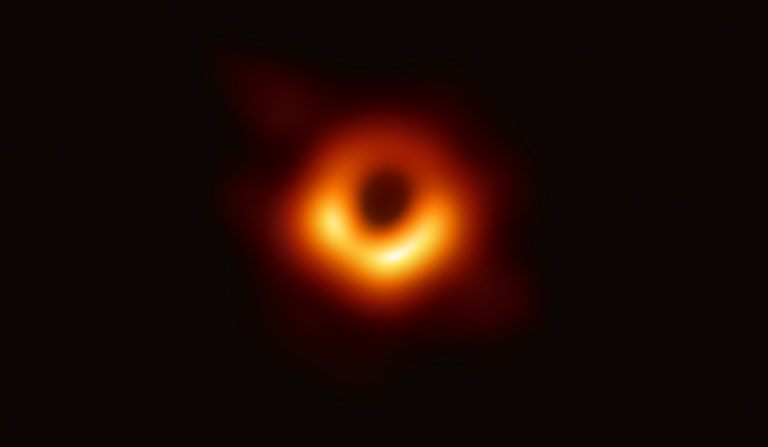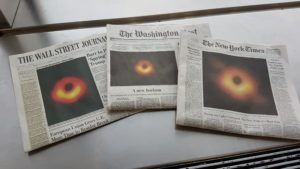Black hole breakthrough: astronomers release landmark image
Humanity’s first look at a black hole has been released by the Event Horizon Telescope collaboration, a globe-spanning consortium of researchers from Perimeter Institute and a dozen partner organizations.

Scientists have seen the unseeable.
This week, after nearly two decades of intense theoretical research and technical ingenuity spanning continents and cultures, researchers from the Event Horizon Telescope (EHT) collaboration shared humanity’s first look at a black hole.
“We have gone right to the edge of the event horizon, and seen the point of no return,” said EHT researcher Avery Broderick, who holds the Delaney Family John Archibald Wheeler Chair at Perimeter Institute. “This is an extraordinary moment in science.”
The image reveals the black hole – an incredibly massive and compact object with gravity so intense that even light cannot escape – at the heart of the Messier 87 (M87) galaxy in the Virgo galactic cluster.
The M87 black hole resides 55 million light-years from Earth and has a mass 6.5-billion times that of our Sun. Black holes are believed to be the core gravitational engines of most galaxies, including our own Milky Way.
The EHT’s observations and resulting image match theoretical predictions with incredible precision. Those predictions date back to Albert Einstein, whose theory of general relativity predicted the bending of light and spacetime by black holes.
The landmark image is the result of a worldwide collaboration of more than 200 researchers from 13 partner organizations – with Perimeter Institute comprising the Canadian contingent – and dozens of affiliate organizations.
“Perimeter is proud to be a partner in this remarkable international collaboration,” said Perimeter Institute Director Robert Myers. “Giving us the first ever picture of a black hole is a spectacular achievement. It inspires us all as to what an extraordinary place the universe really is and how much there is to discover in it.”
Broderick, an associate faculty member at Perimeter Institute and the University of Waterloo (an EHT affiliate organization), was among four EHT researchers who announced the discovery during a press conference on April 10 at the National Press Club in Washington, DC.
Broderick and members of Perimeter’s Event Horizon Telescope Initiative devised a number of key predictive models and simulations that guided the development of the EHT and conducted analysis on the vast amounts of data obtained through the EHT’s observations. A 2014 conference at Perimeter was also one of the key early meetings of the scientific partners behind the EHT.
The image shows a bright circular ring of superheated gas circling the dark patch, where the event horizon – the black hole’s point of no return – absorbs anything that crosses it, creating a black shadow or silhouette.
“This shadow, caused by the gravitational bending and capture of light by the event horizon, reveals a lot about the nature of these fascinating objects and allowed us to measure the enormous mass of M87’s black hole,” said Heino Falcke, chair of Radboud University’s EHT Science Council.
 Creating the EHT was a formidable challenge which required upgrading and connecting a worldwide network of eight pre-existing telescopes deployed at a variety of challenging high-altitude sites. These locations included volcanoes in Hawaii and Mexico, mountains in Arizona and the Spanish Sierra Nevada, the Chilean Atacama Desert, and Antarctica.
Creating the EHT was a formidable challenge which required upgrading and connecting a worldwide network of eight pre-existing telescopes deployed at a variety of challenging high-altitude sites. These locations included volcanoes in Hawaii and Mexico, mountains in Arizona and the Spanish Sierra Nevada, the Chilean Atacama Desert, and Antarctica.
The EHT observations use a technique called very-long-baseline interferometry (VLBI), which synchronizes telescope facilities around the world and exploits the rotation of our planet to form one huge, Earth-sized telescope observing at a wavelength of 1.3mm. VLBI allows the EHT to achieve an angular resolution of 20 micro-arcseconds – resolution great enough to read the fine print on a dime in South Africa from a vantage point in New York City.
The telescopes contributing to this result were ALMA, APEX, the IRAM 30-meter telescope, the James Clerk Maxwell Telescope, the Large Millimeter Telescope Alfonso Serrano, the Submillimeter Array, the Submillimeter Telescope, and the South Pole Telescope. Petabytes of raw data from the telescopes were combined by highly specialized supercomputers hosted by the Max Planck Institute for Radio Astronomy and MIT Haystack Observatory.
While capturing an image of a black hole is a milestone achievement in itself, the greater scientific value comes from having a powerful new tool for understanding the universe’s most mysterious and powerful phenomena. On the day of the announcement, the EHT collaboration published six papers in The Astrophysical Journal Letters, with many more already in process.
“We now have exceptionally strong evidence for the link between supermassive black holes and the centres of active galaxies – this is how black holes shape our universe on galactic scales,” said EHT project director Sheperd S. Doeleman of the Center for Astrophysics | Harvard & Smithsonian. “Breakthroughs in technology, connections between the world’s best radio observatories, and innovative algorithms all came together to open an entirely new window on black holes and the event horizon.”
The release of the landmark image marks a tipping point for astronomy that will open new research paths and enable innovations and technologies.
“This first image doesn’t represent the end of an endeavour, but the beginning of an era,” said Broderick.
“We are now entering an era of empirical strong gravity research – something that just two decades ago was firmly the purview of science fiction. Just as understanding electromagnetism made the information age possible, thoroughly understanding gravity will launch the gravitational age, with benefits we have only begun to imagine.”
Watch “Expanding Horizons,” a panel discussion on the meaning and implications of the EHT results, streaming live April 10 at 11 am ET:
Watch the EHT collaboration’s announcement from Washington, D.C.:
Align EHT telescopes in our online interactive simulation
Globe and Mail feature about Avery Broderick and the EHT black hole
Watch Avery Broderick’s public lecture about the EHT’s black hole hunt
Download free posters celebrating the EHT and its landmark black hole image
Download “Understanding the Image of M87*”— a brand-new classroom resource
WATCH: What are black holes? Event Horizon Telescope scientists explain




















































































